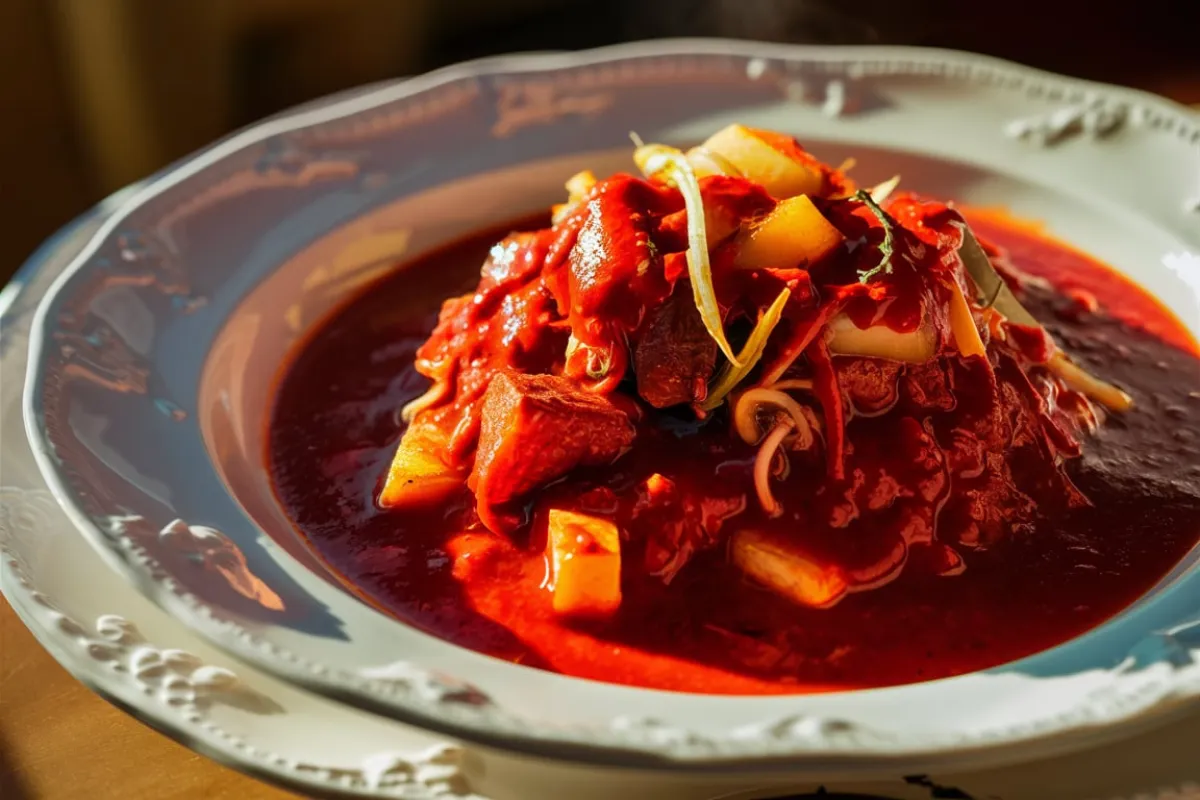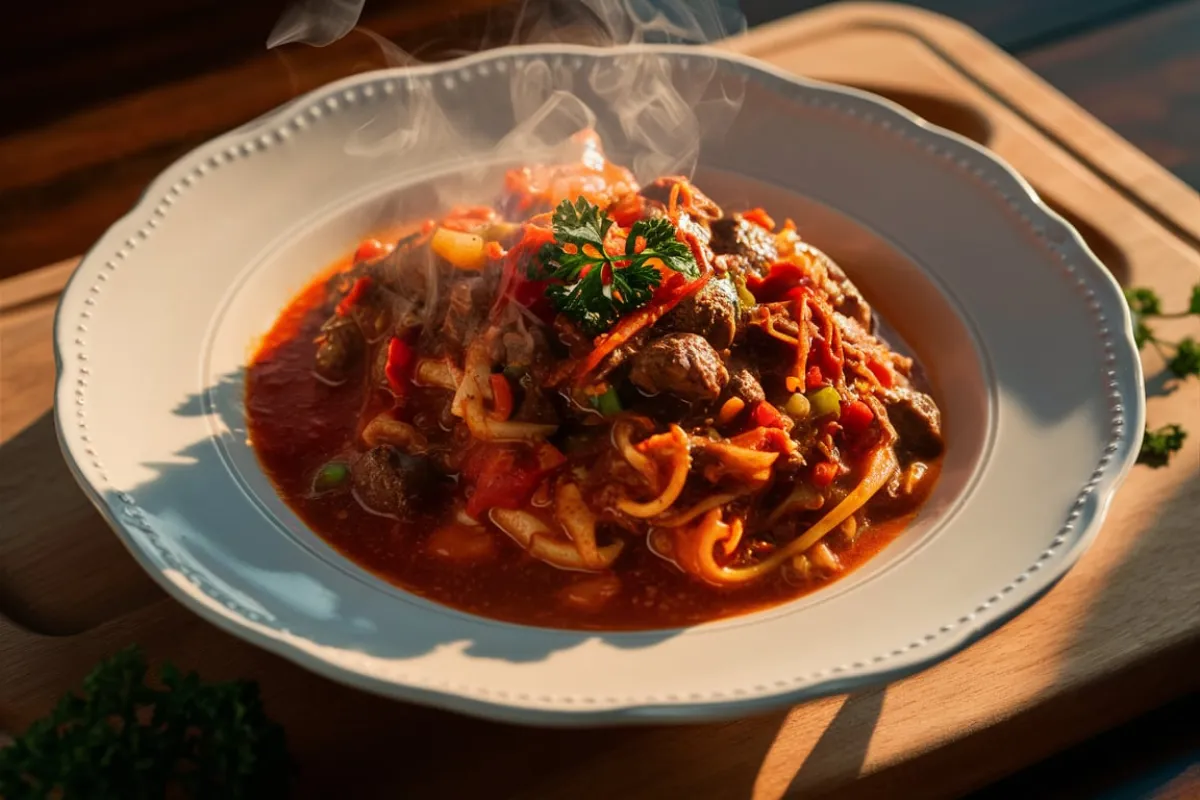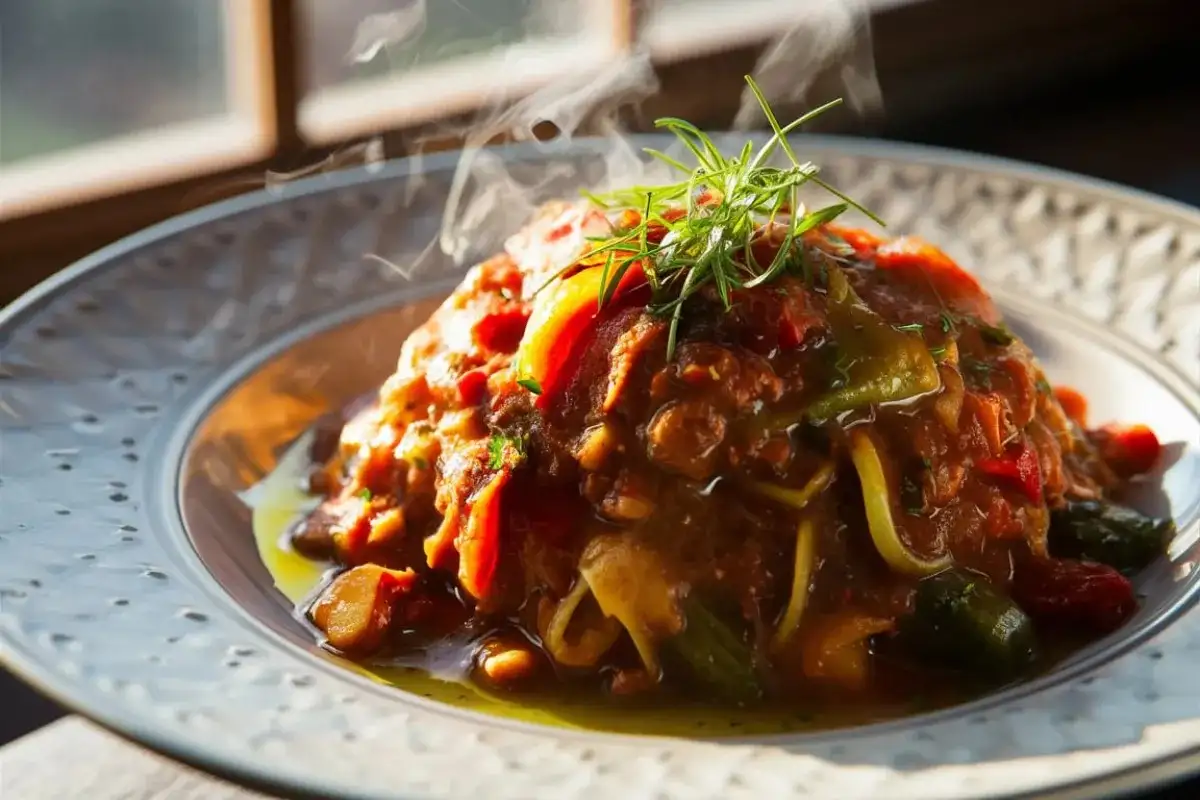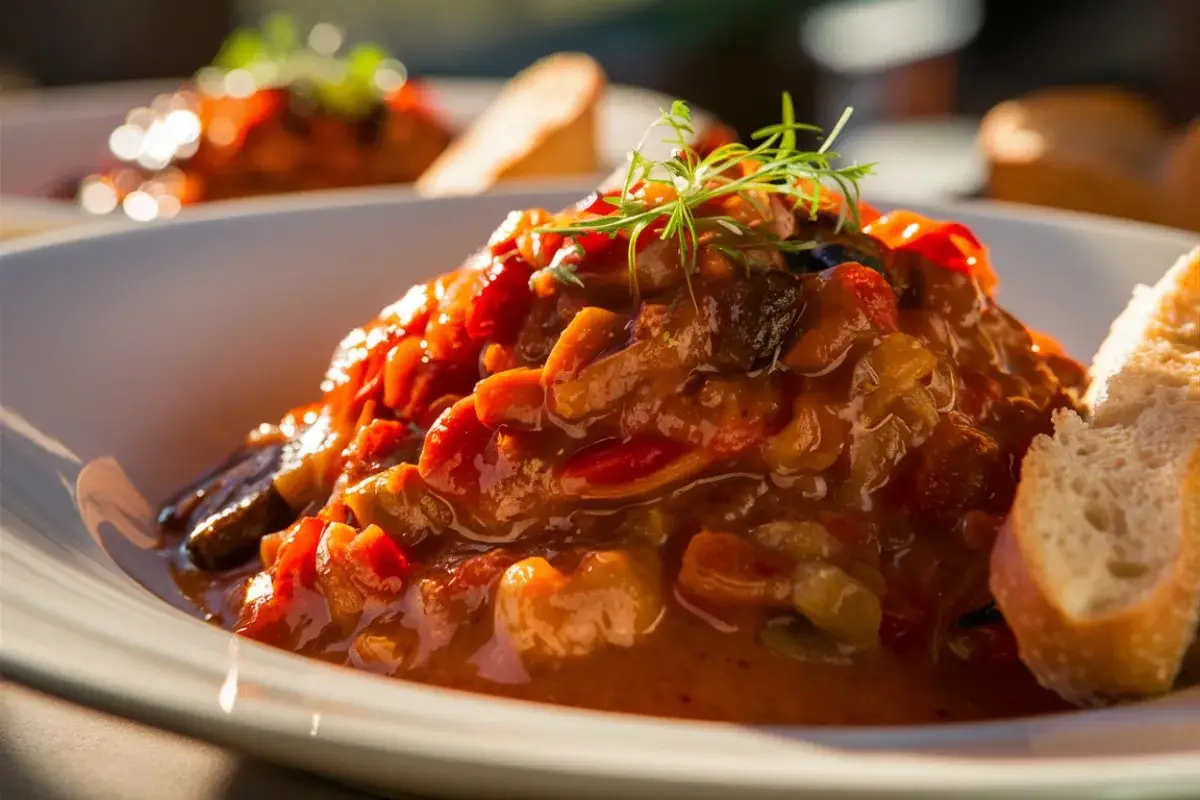Goulash is a beloved dish with deep roots and variations across different cultures. While the word “goulash” may bring to mind a single, hearty dish, it actually refers to several distinct recipes, most notably Hungarian Goulash and American Goulash. Despite sharing a name, these two dishes are fundamentally different in their ingredients, preparation methods, and cultural significance. In this article, we will explore the history, evolution, and reasons why American goulash has developed so differently from its Hungarian counterpart, delving into the factors that have shaped its unique identity.
The Origin and Evolution of Goulash: How American Goulash Became Different
Hungarian Goulash: A Traditional Dish
Hungarian Goulash, or gulyás, has a storied past that dates back to the 9th century. Originally, this dish was prepared by Hungarian shepherds and herdsmen, who needed a filling and easily transportable meal that could sustain them while working in the field. In these early versions of goulash, cooks would simmer meat with onions in an iron kettle until the liquids evaporated, then dry it in the sun, making it easy to carry and rehydrate with water when needed.
Over time, goulash evolved into a more refined dish as cooks added ingredients like paprika, introduced in the 16th century after explorers brought the spice to Europe from the New World. Paprika became a defining feature of Hungarian cuisine, and its rich, smoky flavor turned goulash into a national dish that remains iconic in Hungary to this day. Cooks traditionally make the dish with beef, onions, and a mix of vegetables such as potatoes, carrots, and bell peppers, and slow-cook it over a low flame. This method allows the flavors to meld together, creating a rich and aromatic stew that is both hearty and flavorful.
To learn more about how to prepare this traditional version, you can check out our detailed goulash recipe guide.
American Goulash: An Immigrant Adaptation

When Hungarian immigrants brought goulash to the United States in the late 19th and early 20th centuries, they found themselves in a new world with different ingredients and culinary influences. Cooks adapted the traditional Hungarian preparation, with its focus on beef, vegetables, and paprika, to fit American tastes, available ingredients, and the growing demand for simpler, more convenient meals.
American Goulash—often called “American Chop Suey” in parts of New England evolved into a dish that is distinctly different from its Hungarian namesake. It became a one-pot meal made with ground beef, macaroni pasta, and a tomato-based sauce, seasoned with spices like garlic, oregano, and basil. Instead of using the lengthy slow-cooking process common in Hungary, cooks could quickly prepare American goulash on a stovetop or in a single casserole dish. This shift from stew to a pasta-based dish made it more accessible and practical for American households, especially during the economic hardships of the Great Depression and World War II, when families needed to stretch their budgets and make use of readily available ingredients.
The Ingredients that Define Each Version
Key Ingredients in Hungarian Goulash
Hungarian goulash is distinguished by its reliance on specific ingredients that are integral to its unique flavor profile:
- Beef: Traditionally, Hungarian goulash uses beef, often from tougher cuts like shank or shoulder. These cuts are ideal for slow-cooking, as they become tender and flavorful over time.
- Paprika: This spice is the cornerstone of Hungarian goulash, providing both color and a distinctive smoky, slightly sweet flavor. There are several varieties of paprika, ranging from mild to hot, and the choice can significantly impact the dish’s final taste. Learn more about the different types of paprika and their uses.
- Onions: Onions form the base of the stew, offering depth and sweetness that balances the spices and the richness of the meat.
- Vegetables: Commonly used vegetables include potatoes, carrots, and bell peppers, which add texture and natural sweetness to the dish.
- Broth or Water: Cooks often prepare the stew in a broth or water, which helps to blend the flavors and achieve the desired consistency.
- Caraway Seeds and Garlic: These are optional but often used to add a hint of complexity and additional layers of flavor.
Key Ingredients in American Goulash: What Makes It So Different from Hungarian Goulash?
In contrast, American goulash has a different set of core ingredients that reflect its adaptation to American culinary preferences:
- Ground Beef: Instead of large chunks of meat, American goulash uses ground beef, which cooks quickly and evenly, making it suitable for a one-pot dish.
- Macaroni Pasta: Elbow macaroni or other small pasta shapes are a defining characteristic of American goulash, setting it apart from its Hungarian counterpart.
- Tomato-Based Sauce: A combination of canned tomatoes, tomato sauce, or tomato paste forms the base, giving the dish its characteristic red color and tangy flavor.
- Spices and Seasonings: While Hungarian goulash relies heavily on paprika, American goulash uses a blend of Italian seasonings like oregano, basil, and sometimes bay leaves, reflecting the influence of Italian-American cuisine.
- Cheese (Optional): Some variations include shredded cheese, either mixed in or melted on top, adding a creamy, comforting element to the dish.
For those interested in exploring different ways to use ground beef, our guide on ground beef recipes offers plenty of delicious options.
Cooking Techniques: Stew vs. One-Pot Meal
Hungarian Goulash Cooking Techniques

Hungarian goulash preparation reflects its historical origins and the needs of the Hungarian people. Cooks traditionally prepare this dish slowly over a low flame in a heavy pot, allowing the meat to tenderize and the flavors to meld together. The slow-cooking method is crucial, as it draws out the flavors of the paprika and other spices, creating a deep, complex stew that is both hearty and aromatic.
- Slow Cooking in a Kettle: Traditionally, Hungarian goulash is prepared in a kettle or cauldron, often over an open flame. Hungarians know this method as ‘bogrács’ cooking, and it remains popular in rural areas and at festivals.
- Layering of Flavors: Ingredients are added in stages to build flavor. Onions are cooked first to create a flavorful base, followed by beef and paprika. Cooks add the vegetables and liquids later, allowing each component to contribute to the stew’s overall depth.
- Extended Cooking Time: Cooks simmer the dish slowly, often for several hours, until the meat becomes tender and the broth thickens to the desired consistency.
American Goulash Cooking Techniques
By contrast, American goulash caters to convenience and speed, reflecting the needs of busy American families. You can quickly prepare this version in one pot or a casserole dish, making it a favorite weeknight meal.
- Browning the Meat: The process begins with browning ground beef in a pot, which adds a rich, savory flavor base.
- Combining Ingredients in One Pot: All ingredients, including pasta, tomato sauce, and seasonings, are added to the pot. This approach simplifies the cooking process and minimizes clean-up, a key appeal for many home cooks.
- Quick Cooking: Cooks can prepare the dish relatively quickly, typically within 30 to 40 minutes, making it a practical choice for busy households.
If you want to experiment with other quick one-pot meals, try our recipe for taco pasta, which adds a fun twist to traditional pasta dishes.
Cultural Significance and Evolution
Hungarian Goulash: A Symbol of National Identity
In Hungary, goulash is much more than just a meal—it is a cultural icon. Often associated with the Hungarian countryside and the traditions of herdsmen, it represents a connection to the country’s pastoral past. People commonly serve it at national celebrations and family gatherings, where they view its preparation and enjoyment as expressions of national pride.
Festivals across Hungary also celebrate the dish, often showcasing traditional methods in competitions. For many Hungarians, the act of cooking goulash in a “bogrács” is as important as the ingredients themselves. This ritualistic aspect is central to its status as a national dish.
American Goulash: A Reflection of Adaptation and Practicality
American goulash, meanwhile, is a testament to the American spirit of adaptation and practicality. As immigrants from Hungary and other parts of Europe settled in America, they brought their culinary traditions with them. However, the need to adapt these recipes to new environments and available ingredients led to the creation of a dish that is uniquely American.
The American version of goulash became particularly popular during the economic hardships of the Great Depression and World War II, when families had to make do with what they had. Ground beef was more affordable and accessible than large cuts of meat, and pasta provided a cheap way to stretch the dish further. The result was a meal that was both filling and easy to prepare, quickly becoming a staple in American households.
This spirit of adaptation also shines in other American classics, such as our rotisserie chicken recipes, which showcase a variety of ways to repurpose ingredients for maximum flavor and convenience.
Regional Variations and Modern Twists
Variations Across the United States

One of the fascinating aspects of American goulash is its ability to adapt and change depending on regional preferences:
- New England Style (“American Chop Suey”): In New England, American goulash is often called “American Chop Suey.” This version may include bell peppers, Worcestershire sauce, or a touch of hot sauce for added flavor.
- Midwestern Variations: In the Midwest, people typically make American goulash with ground beef, macaroni, and a tomato-based sauce. Some variations include the addition of cheese, either melted on top or mixed in, creating a creamy texture.
- Southern Twists: In the Southern U.S., you might find goulash recipes that incorporate local ingredients like okra or smoked sausage, adding a regional flair to the dish.
These variations highlight the adaptability of American goulash, reflecting local tastes and ingredients. For more inspiration on how to mix up your goulash, consider what to serve with goulash for a complete meal.
Modern Twists and Creative Takes
American goulash continues to evolve with the times, embracing new trends and ingredients. Today, you can find countless creative variations, from vegetarian and vegan versions to those that incorporate different types of pasta or alternative proteins like turkey or chicken.
Food bloggers and chefs have put their spin on the classic recipe, experimenting with different spices, adding vegetables, or incorporating international flavors. The dish’s versatility and simplicity make it a perfect canvas for creativity, allowing cooks to tailor it to their tastes and dietary preferences.
Goulash as Comfort Food
Both Hungarian and American goulash hold a special place in their respective cultures as comfort foods. For many, they evoke a sense of nostalgia and home, whether it’s the slow-simmered, paprika-rich stews of Hungary or the quick, savory pasta dishes of America.
- Hungarian Goulash: Often enjoyed during cold winters or at family gatherings, Hungarian goulash is a dish that brings people together. Its robust flavors and hearty ingredients provide warmth and sustenance, making it a beloved comfort food across Hungary.
- American Goulash: In the United States, American goulash is often associated with family dinners, potlucks, and community gatherings. Its simple preparation and satisfying taste make it a go-to meal for busy weeknights or when feeding a crowd. The addition of cheese and pasta also gives it a creamy, comforting texture that appeals to both children and adults.
For a similar dish that brings warmth and comfort, explore our taco pasta recipe, a fusion of familiar flavors that’s sure to become a family favorite.
Frequently Asked Questions:
- What is the main difference between Hungarian and American goulash?
The main difference is that Hungarian goulash is a traditional stew made with chunks of beef, paprika, and vegetables, while American goulash is a quicker, one-pot dish made with ground beef, macaroni, and a tomato-based sauce. - Why is American goulash considered a comfort food?
People consider American goulash comfort food because it’s easy to prepare, uses simple ingredients, and offers a hearty, satisfying meal that many associate with home-cooked, family dinners. - Can American goulash be made vegetarian?
Yes, you can make American goulash vegetarian by substituting ground beef with plant-based protein alternatives and adding more vegetables. - How did American goulash evolve over time?
American goulash evolved from its Hungarian origins due to the influence of immigrant communities, economic factors like the Great Depression, and the American preference for quick and easy recipes. - What are some common variations of American goulash?
Common variations include adding cheese for a creamy texture, using different vegetables like bell peppers or zucchini, and preparing it in a slow cooker for convenience.
Conclusion: A Tale of Two Goulashes
In conclusion, the differences between American goulash and Hungarian goulash are more than just culinary—they are a reflection of the diverse cultural, historical, and social contexts in which these dishes developed. Hungarian goulash is a rich, slow-cooked stew deeply embedded in the national identity of Hungary, while American goulash is a versatile, quick-to-make dish that speaks to the adaptability and practicality of American home cooking.
Despite their differences, both versions of goulash share a common thread: they are dishes born out of necessity, designed to provide comfort and sustenance. Whether you prefer the traditional flavors of Hungarian goulash or the simple, satisfying taste of American goulash, each offers a unique and delicious way to enjoy a classic dish.

